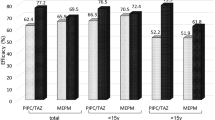Summary
The combination of piperacillin with tazobactam (PIP/TAZ) extends the activity of piperacillin against gram-positive, gram-negative, and anaerobic bacteria. The broad-spectrum of this formulation, together with its low degree of organ toxicity observed in adults, makes PIP/TAZ a tempting choice for children with radio-/chemotherapy-induced neutropenia. However, the use of PIP/TAZ is not yet approved for children under 12 years of age. The tolerability of PIP/TAZ was assessed in 19 children and adolescents between 2 and 18 years of age who developed a fever during aplasia after high dose radio-/chemotherapy and autologous stem cell transplantation (HD-SCT) for primary multifocal or relapsed solid tumours. Treatment with PIP/TAZ was initiated on average 3 days after HD-SCT, and the treatment was continued for approximately 10 days. Both clinical observation and laboratory studies showed no relevant alterations that would have been attributable to PIP/TAZ treatment. These results indicate that PIP/TAZ appears to be well tolerated in children during the acute phase of HD-SCT.
Similar content being viewed by others
References
Adam, D.: Klinische Studien mit Tazobactam/Piperazillin. FAC 11 (1992) 467–473.
Akova, M., Yang, Y., Livermore, D. M.: Interactions of tazobactam and clavulanate with inducible and constitutively expressed class I betalactamases. J. Antimicrob. Chemother. 25 (1990) 199–208.
Fauser, A. A.: Hochdosis-Chemotherapie mit peripherer Blutstammzelltransplantation. Tazobactam-geschütztes Piperacillin (Tazobac®) bewährt sich bei febrilen Neutropenien. Int. J. Exp. Clin. Chemother. 7 (Suppl. 2) (1995) 21–24.
Rosenstiel, N.-A. von, Grimm, H.: Antibiotic profile: piperacillin/ tazobactam. Antiinf. Drugs Chemother. 14 (1996) 187–199.
Sörgel, F., Kinzig, M.: The chemistry pharmacokinetics and tissue distribution of piperacillin/tazobactam. J. Antimicrob. Chemother. 31 (Suppl. A) (1993) 39–60.
Nürnberger, W., Kruck, H., Mauz-Körholz, C., Burdach, St., Göbel, U.: Humoral coagulation and early complications after allogeneic bone marrow transplantation. Klin. Pädiatr. 209 (1997) 209–215.
Kuye, O., Teal, J., De Vries, V. G., Morrow, C. A., Taly, F. P.: Safety profile of piperacillin/tazobactam in phase I and phase III clinical studies. J. Antimicrob. Chemother. 31 (Suppl. A) (1993) 113–124.
Livermore, D. M., Chen, H. Y., Bonfiglio, B.: Betalactamase-mediated resistance and its reversal by tazobactam and other inhibitors. FAC 11 (1992) 379–388.
Author information
Authors and Affiliations
Rights and permissions
About this article
Cite this article
Nürnberger, W., Bönig, H., Burdach, S. et al. Tolerability of piperacillin/tazobactam in children and adolescents after high dose radio-/chemotherapy and autologous stem cell transplantation. Infection 26, 65–67 (1998). https://doi.org/10.1007/BF02768763
Issue Date:
DOI: https://doi.org/10.1007/BF02768763



